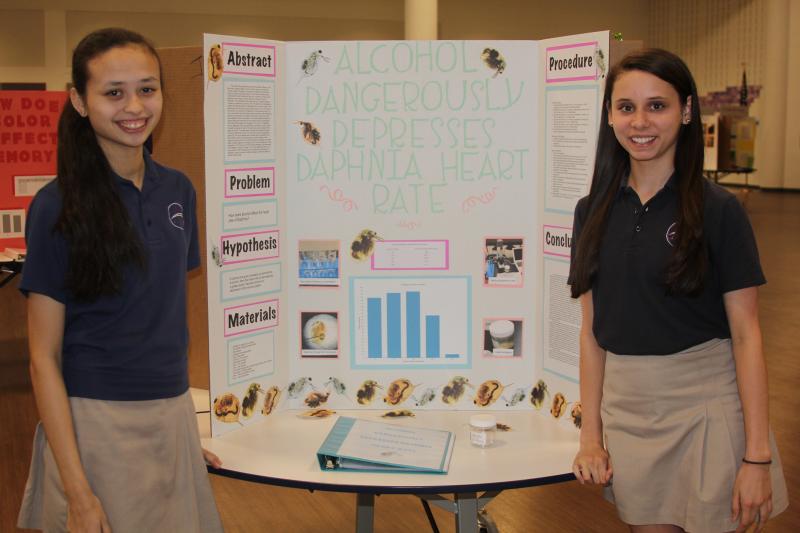Sussex Academy sophomore Kellie Heinlein smiles timidly as she talks about her science project. Her classmate, Emily Fried, 16, helps explain how they used tiny, microscopic organisms called Daphnia to determine the effects of ethanol on heart rate.
“We wanted to see how alcohol is dangerous,” Emily said. “Their heart rate changed when they drank ethanol.”
A bar graph centered on the girls' trifold display showed how heart rates decrease – to the point of death – when Daphnia ingest too much ethanol. The girls also observed Daphnia with little or no ethanol exposure and compared the results.
The girls worked together and started their project in October, finishing at the end of March. Their project was one of dozens throughout Sussex Academy during the school's science fair.
Elijah Boladas, 15, tested store bought apples and carrots to see how much bacteria he could see under a microscope. His theory was that organic foods may have more bacteria, but it's not bad bacteria that harms humans. The “good” bacteria is necessary to protect humans against Ebola, Salmonella and other destructive outbreaks, he said.
“My friend only eats organics, and he says it's an added benefit,” Elijah said.
Elijah said he got an idea for his project when Chipotle restaurants came under fire for their contaminated produce. Through his research, he learned hand sanitizers remove a lot of bacteria, but not all of it. Harmful bacteria can remain, and young children are particularly susceptible because of their immature immune systems, he said.
Seventh-grader Nate Abbott used a short, street-scene video to show people how much detail they can miss, even if they are paying attention. “Did you see the dancing bear?” he asked. On a slow-motion review, there it was.
“It proves that there is a fine line between paying attention and not. Switching from one task to another is distracting,” he said.
Students in sixth, seventh, eighth and 10th grades put together projects for a research symposium that also featured presentations by Marine Education, Rescue and Rehabilitation, aerospace manufacturer ILC from Frederica and graduate students from University of Delaware College of Earth, Ocean and Envionment.
At the ILC table, Jinny Ferl, an engineering manager for space suits, had samples of space suit material made to repeal space dust.
The material also repeals water. “Put a drop on it and it'll shoot across,” she said.
Sixth-grader Andrea Hastings thought the demonstration was cool as drops of water glided across the space suit material. “Look how that moves. It's really neat,” she said.
A panel of judges awarded winners in each grade. This year's school winners were:
Sixth grade: Samantha Oliver, Mari Dopler and Mikayla Dayton
Seventh grade: Else Leebel, Lindy Truitt and Jenna Gibbons
Eighth grade: Jessica Truitt, Sarah Cullen and Alli Dayton
10th grade: First place - Emily Fried and Kelly Heinlein, "Alcohol Dangerously Depresses Daphnia Heart Rate"; second place - Finn Davis, "The Effect of Rainfall on Groundwater Recharge"; third place - Elijah Bolades, "What Calls Your Food Home"; honorable mention - Noah Garrison, “Batted Ball Coefficient of Restitution.”
Melissa Steele is a staff writer covering the state Legislature, government and police. Her newspaper career spans more than 30 years and includes working for the Delaware State News, Burlington County Times, The News Journal, Dover Post and Milford Beacon before coming to the Cape Gazette in 2012. Her work has received numerous awards, most notably a Pulitzer Prize-adjudicated investigative piece, and a runner-up for the MDDC James S. Keat Freedom of Information Award.




















































